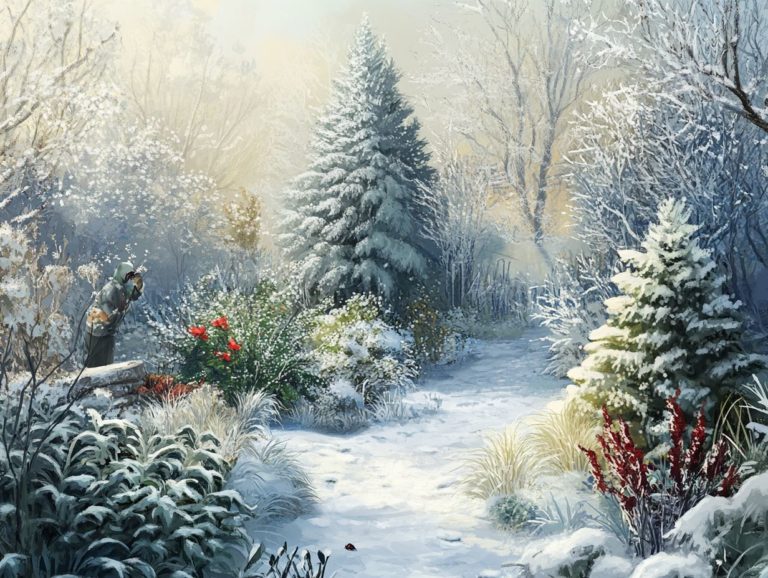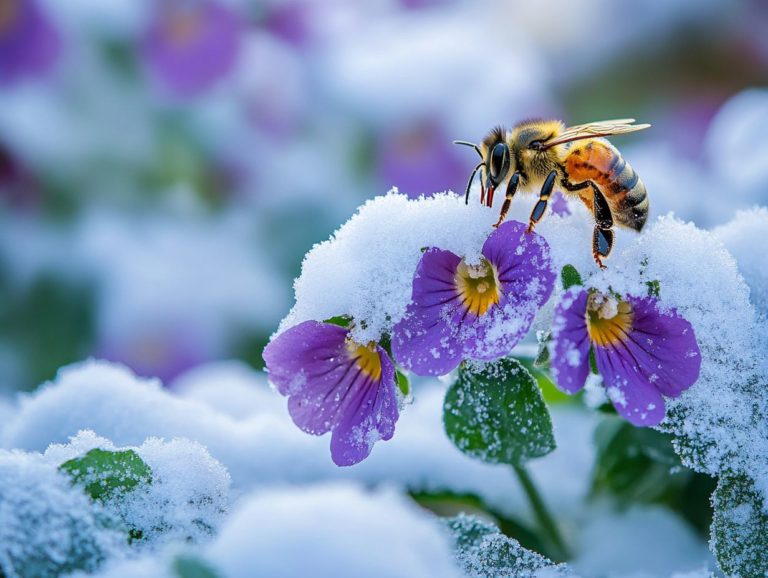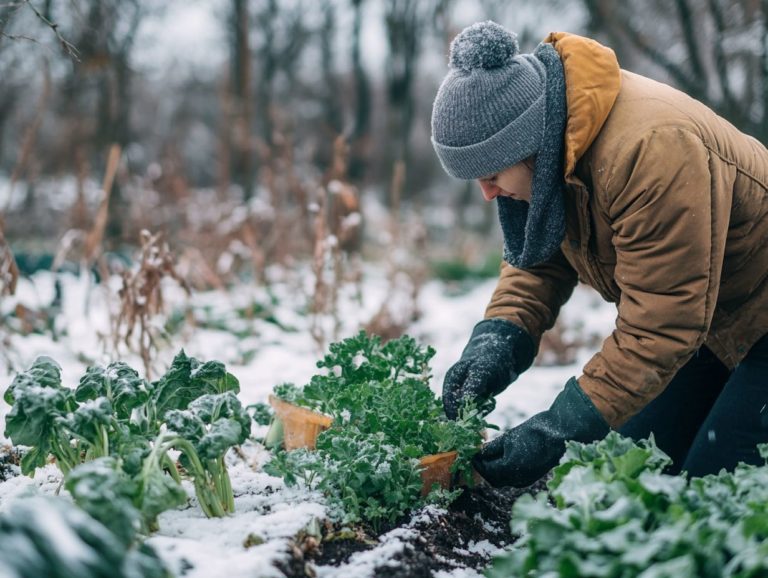How to Use Cold Frames for Winter Gardening
If you re keen on nurturing your garden during the chillier months, cold frames could be just what you need! They provide great benefits for winter gardening, helping you grow vibrant vegetables even when it s chilly outside.
Consider how to select the optimal location, construct and maintain your cold frame, and discover the best plants to thrive in this inviting environment.
Embrace the art of winter gardening and unlock the full potential of your outdoor space!
Contents
- Key Takeaways:
- Benefits of Using Cold Frames for Winter Gardening
- Choosing and Preparing a Location for Your Cold Frame
- Building and Maintaining a Cold Frame
- What to Grow in a Cold Frame
- Frequently Asked Questions
- What are cold frames and how are they used for winter gardening?
- How do I prepare my cold frame for winter gardening?
- What types of plants can I grow in a cold frame during the winter?
- How do I regulate the temperature in my cold frame?
- When should I start using my cold frame for winter gardening?
- Can I use my cold frame for winter gardening in all climates?
Key Takeaways:

- Extend your growing season with cold frames by creating a protected environment for plants during winter months.
- Save money on heating and protect plants from harsh weather by using cost-effective cold frame solutions.
- Choose a suitable location and maintain your cold frame properly for successful winter gardening.
What is a Cold Frame?
A cold frame acts as a shield in vegetable gardening, creating a special climate (a controlled environment that helps plants grow better) that keeps your plants cozy and safe from harsh weather.
Typically featuring a glass top and insulated materials, cold frames help you grow cool-season vegetables and keep delicate seedlings safe from freezing temperatures.
This technique gives you the power to cultivate various crops, like leafy greens such as spinach and lettuce, even when temperatures drop. It s an invaluable asset for dedicated gardeners!
With designs ranging from simple wooden boxes to more intricate greenhouse-like structures, you can choose a cold frame that fits perfectly with your space and gardening goals.
You might even consider repurposing old windows for the cover and using reclaimed wood for the frame promoting sustainability and ensuring durability.
The benefits extend beyond frost protection. Cold frames create an ideal environment for seed germination and early plant growth. This technique can boost your productivity dramatically, allowing for staggered sowing and increased harvests.
Benefits of Using Cold Frames for Winter Gardening
Cold frames offer many advantages, acting as protective structures that let you grow fresh vegetables even in colder months.
By adding a cold frame to your gardening routine, you can significantly boost your vegetable production and extend your growing season for cool-season crops like kale, arugula, and radicchio. Implementing tips for sustainable winter gardening can further enhance your efforts.
Portable cold frames safeguard your plants from frost and offer a cost-effective way to enhance your winter gardening. Additionally, using aquaponics for winter gardening can allow for a continuous harvest all year round.
Extended Growing Season
One primary advantage of using a cold frame is the extended growing season. This allows you to enjoy fresh vegetables long after the traditional planting season is over.
By creating a protective environment, this simple structure ensures that your crops like lettuce, spinach, and even resilient root vegetables such as carrots can thrive well into the fall and early spring months.
To maximize the benefits, place your cold frame where it can receive maximum sunlight, effectively transforming it into your mini greenhouse.
Incorporating crop rotation within the frame leads to healthier soil and increased yields. For example, follow leafy greens with a hearty crop like radishes to maintain a nutrient balance.
Combining these techniques not only promotes robust plant growth but also contributes to sustainable gardening practices you can be proud of!
Protection from Harsh Weather
Cold frames offer essential protection against harsh weather conditions. They provide frost protection and temperature control for frost-sensitive crops that would otherwise struggle in extreme temperatures.
Think of these structures as miniature greenhouses. They create a stable microclimate that encourages growth even when the outside world is less than hospitable. By capturing heat from the sun during the day, cold frames ensure that your vegetable crops stay insulated from the biting cold as nighttime temperatures dip.
They act as a shield against snow. While snow can insulate the ground, it may lead to unwanted moisture accumulation. This balance of protection and ventilation safeguards tender plants like lettuce and spinach from drying out and frostbite.
This strategy allows you to cultivate year-round and maximize your yield potential.
Cost-Effective Solution

Building a cold frame is a savvy solution for winter gardening. It offers you the chance to create your own protective structure while indulging in a rewarding DIY project. Additionally, learning how to use a greenhouse in winter gardening can further enhance your gardening efforts.
Use affordable materials like old windows or reclaimed wood. You can craft a customized cold frame that suits your gardening needs. This hands-on approach sparks creativity and allows for flexibility in design, easily accommodating your budget constraints.
The advantages are numerous. Cold frames extend your growing season and shield delicate seedlings from harsh weather. They can significantly enhance your crop yields.
By employing various techniques like adjusting the angle for optimal sunlight exposure you can further boost plant growth. Embracing DIY practices in gardening proves to be both sustainable and economically wise.
Choosing and Preparing a Location for Your Cold Frame
Selecting and preparing the ideal location for your cold frame is vital for maximizing its efficiency. The chosen spot significantly influences the sunlight your plants receive and how well they are shielded from bad weather.
Factors to Consider
When choosing a location for your cold frame, it s essential to weigh several key factors that will impact your gardening success. First and foremost, maximize sunlight exposure to effectively control temperature and promote optimal vegetable growth.
Your geographical setting is critical. Areas bathed in prolonged sunlight are ideal, while locations overshadowed by trees or buildings may struggle with inadequate light. This shading can impact the internal temperature of your cold frame, which is a key element for seed germination and overall plant health.
Also, consider how close your cold frame is to water sources. Having easy access simplifies your irrigation process and ensures that the soil remains adequately moist. This greatly enhances the productivity of your gardening efforts.
Preparing the Ground
Preparing the ground for your cold frame is essential for cultivating a nutrient-rich soil environment. This promotes healthy plant growth and effective temperature control.
This process involves several critical steps to ensure your gardening foundation is solid:
- First, assess the current soil quality by testing its pH and nutrient content. This will empower you to make informed amendments.
- Next, consider adding organic matter like compost or well-rotted manure. This enriches the soil and enhances its structure.
- After incorporating these amendments, level the area thoroughly to create an even planting surface. This is crucial for maintaining moisture and maximizing sunlight exposure.
- If space permits, raised beds can provide better drainage and warmer soil temperatures, ultimately fostering a productive environment for your plants.
Building and Maintaining a Cold Frame
Building and maintaining a cold frame requires you to choose the right materials and construction techniques. This ensures both durability and effectiveness.
Choose your materials wisely! This will set you up for successful winter gardening, allowing you to extend your growing season and nurture your plants even in the colder months.
Materials and Construction

The choice of materials for your cold frame is crucial in its construction, with options ranging from wood and PVC to glass tops that enhance insulation and temperature control.
Each material has its own set of advantages and disadvantages, catering to various gardening needs. For example, wooden frames offer excellent sturdiness and insulation, but they require regular maintenance to stave off rotting.
On the flip side, PVC is durable and resistant to the elements, although it might not retain heat as effectively as wood.
Glass tops can maximize sunlight exposure, but they can also be heavy and fragile, requiring careful handling. Understanding these nuances is essential as you decide on the best practices for building a cold frame that optimally supports plant growth and shields your crops from harsh weather.
Maintenance and Care Tips
To keep your cold frame running smoothly for years, proper maintenance is key. This involves regular tasks like cleaning and utilizing temperature-activated venting to create the perfect growing environment.
To keep those glass tops crystal clear, simply mix a gentle solution of soap and water, then rinse thoroughly to eliminate any residue that might block precious sunlight.
Efficient ventilation is crucial. By managing it through strategically placed adjustable openings, you can regulate temperature and humidity levels inside the frame, preventing overheating and fostering healthy plant growth.
Regularly inspect your frame for damage to keep it in top shape. Look for signs such as cracks in the glass or loose hinges. Addressing these issues promptly is essential for prolonging the life span of this invaluable gardening tool.
Finally, ensure the frame is securely anchored to prevent it from being dislodged by strong winds. By following these steps, you’ll unlock the full potential of your cold frame!
What to Grow in a Cold Frame
Curious about what to grow in your cold frame? Let’s dig in! When you think about what to cultivate in a cold frame, prioritize winter crops and cool-season vegetables that flourish in this sheltered setting. For specific guidance, check out these tips for growing microgreens in winter. This approach guarantees a consistent supply of harvestable produce throughout the colder months, allowing you to enjoy fresh ingredients even when the temperatures drop.
Best Plants for Winter Gardening
Among the finest plants for winter gardening in a cold frame, you ll find nutrient-rich leafy greens like spinach, kale, and chard. These greens thrive in optimal conditions, significantly boosting your vegetable production.
These crops flourish in cool climates with ample indirect sunlight, making them perfectly suited for cold frames. For spinach, the best planting times are late summer or early fall, while kale and chard can be sown from late summer through early spring.
To ensure robust growth, it’s crucial to maintain consistent moisture levels and shield your plants from harsh winds. Keep a watchful eye for pests and diseases to safeguard their health. By prioritizing these greens, you can enjoy a steady supply of fresh produce throughout the winter months.
Frequently Asked Questions
What are cold frames and how are they used for winter gardening?

Cold frames are structures made of transparent material, such as glass or plastic. They protect plants from cold temperatures in the winter by trapping heat from the sun to create a warm, small environment that’s ideal for plant growth.
How do I prepare my cold frame for winter gardening?
First, choose a suitable location for your cold frame, preferably in an area that receives ample sunlight. Clear the area of any debris and level the ground. To enhance your setup, consider how to use heat mats for cold-weather crops by filling the base of the cold frame with a layer of organic material, such as straw or leaves, to provide insulation for the plants.
What types of plants can I grow in a cold frame during the winter?
Cold frames are best suited for cold-weather crops such as lettuce, spinach, kale, and radishes. Additionally, you can learn how to use row covers for winter crops to grow cool-weather herbs and flowers or even start seedlings for spring planting in your cold frame.
How do I regulate the temperature in my cold frame?
Cold frames can easily overheat on sunny days. Check the temperature and provide ventilation as needed.
Prop open the lid or install a thermometer inside to track the temperature effectively.
When should I start using my cold frame for winter gardening?
Start using your cold frame as soon as possible before the first frost. To maximize your garden’s potential, consider learning how to use compost in cold-weather gardening. This gives your plants time to settle in and thrive before it gets cold.
Can I use my cold frame for winter gardening in all climates?
Cold frames work best in mild to moderate climates. However, with good insulation, you can use them in colder areas, too.






